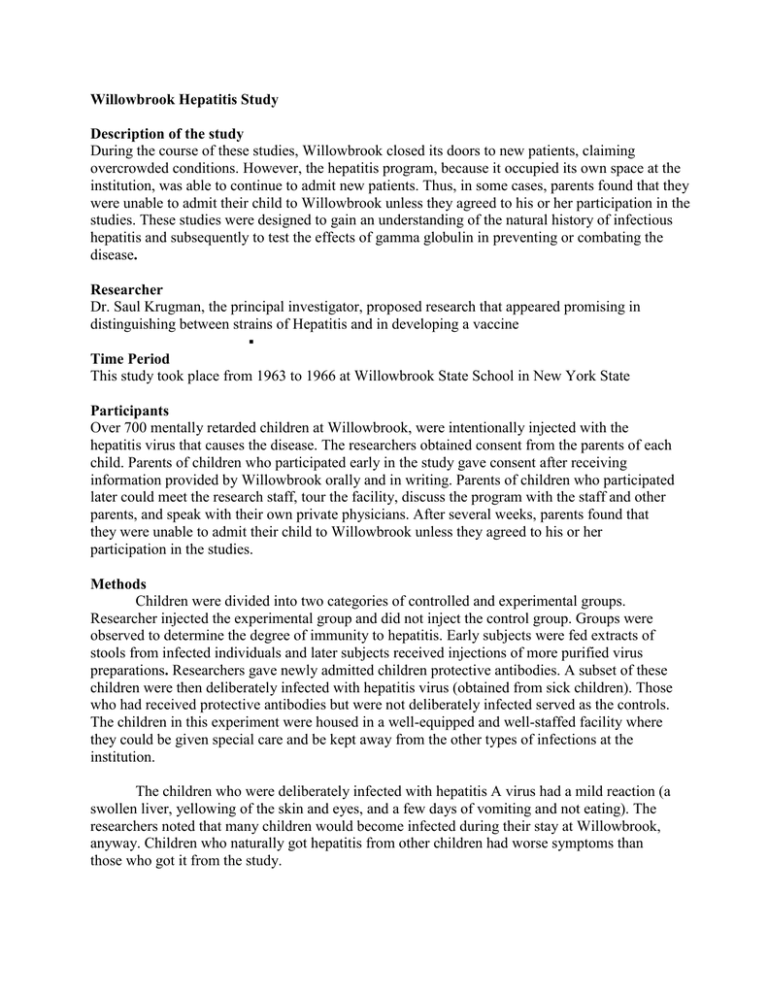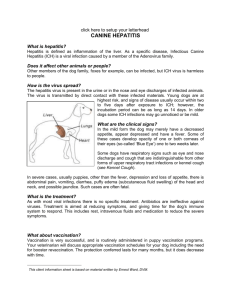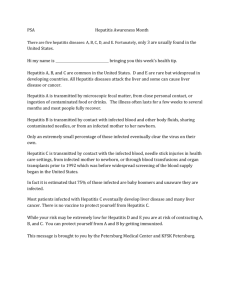Willowbrook Hepatitis Study Description of the study During the
advertisement

Willowbrook Hepatitis Study Description of the study During the course of these studies, Willowbrook closed its doors to new patients, claiming overcrowded conditions. However, the hepatitis program, because it occupied its own space at the institution, was able to continue to admit new patients. Thus, in some cases, parents found that they were unable to admit their child to Willowbrook unless they agreed to his or her participation in the studies. These studies were designed to gain an understanding of the natural history of infectious hepatitis and subsequently to test the effects of gamma globulin in preventing or combating the disease. Researcher Dr. Saul Krugman, the principal investigator, proposed research that appeared promising in distinguishing between strains of Hepatitis and in developing a vaccine Time Period This study took place from 1963 to 1966 at Willowbrook State School in New York State Participants Over 700 mentally retarded children at Willowbrook, were intentionally injected with the hepatitis virus that causes the disease. The researchers obtained consent from the parents of each child. Parents of children who participated early in the study gave consent after receiving information provided by Willowbrook orally and in writing. Parents of children who participated later could meet the research staff, tour the facility, discuss the program with the staff and other parents, and speak with their own private physicians. After several weeks, parents found that they were unable to admit their child to Willowbrook unless they agreed to his or her participation in the studies. Methods Children were divided into two categories of controlled and experimental groups. Researcher injected the experimental group and did not inject the control group. Groups were observed to determine the degree of immunity to hepatitis. Early subjects were fed extracts of stools from infected individuals and later subjects received injections of more purified virus preparations. Researchers gave newly admitted children protective antibodies. A subset of these children were then deliberately infected with hepatitis virus (obtained from sick children). Those who had received protective antibodies but were not deliberately infected served as the controls. The children in this experiment were housed in a well-equipped and well-staffed facility where they could be given special care and be kept away from the other types of infections at the institution. The children who were deliberately infected with hepatitis A virus had a mild reaction (a swollen liver, yellowing of the skin and eyes, and a few days of vomiting and not eating). The researchers noted that many children would become infected during their stay at Willowbrook, anyway. Children who naturally got hepatitis from other children had worse symptoms than those who got it from the study. The effect of gamma globulin in the prevention of infectious hepatitis was studied in four controlled trials in an institution where the disease was highly endemic. In the first trial a single dose of 0.01 ml. per pound of body weight was followed by a two and one-half-fold reduction in incidence of hepatitis with jaundice in a group of patients, predominantly children. When the same dose was given simultaneously to adult hospital attendants, it was ineffective. In the second and third trials inoculation of 0.06 ml. of gamma globulin per pound of body weight was followed by a tenfold and thirtyfold reduced incidence of overt jaundice. In a fourth trial a small group of newly admitted patients was studied intensively for subclinical infection. Under the conditions of this trial clinically inapparent hepatitis occurred in spite of gamma globulin. The ratio of subclinical anicteric hepatitis to overt jaundice was 12:1. Results The study was done to get a better understanding of infectious hepatitis, and to also "test the effects of gamma globulin in preventing or ameliorating the disease." Researchers noticed differing symptoms caused by different virus samples. They concluded that there are two strains of hepatitis, A and B. Hepatitis B is more difficult to pass on to others because it is spread through blood and sexual contact. Hepatitis B can lead to long-term (chronic) infection. References Rothman, D., and Rothman, S. 1984. The Willowbrook Wars. Cambridge: HarperCollins, pages 265–266. Grossman, Joel B. (Winter 1987). "Beyond the Willowbrook Wars: The Courts and Institutional Reform". American Bar Foundation Research Journal 12 (1): 249–259. Krugman, Saul., Ward, Robert., Giles, Joan., & Jacobs, A. Milton. (1960). Infectious Hepatitis: Studies on the effect of gamma globulin and on the incidence of inapparent infection. The Journal of the American Medcal Association. (174), 7. Group 5: Casey Larkin Wendell Larkin Katrina McHuley






